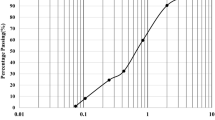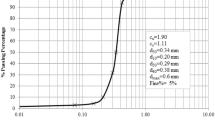Abstract
The latest advancements in the area of soil reinforcing techniques based on geosynthetics have pushed researchers to enhance new approaches to advance the benefits obtained from the reinforced soils. In this regard, the approach of wraparound reinforcement has made further advancement in the soil’s bearing capacity, but the technique is destitute of the applicable recommendations for the geometrical configuration parameters, soil–reinforcement interaction, and failure mechanism. Within this scope, a test setup was prepared to apply strip loads on densely compacted reinforced sand (Dr = 0.7) under the plane strain condition. The tank containing the reinforced sand was a rectangular prism with perfect transparency, and its interior dimensions were 960 mm × 200 mm × 650 mm. Firstly, optimum values of design variables such as embedment depth of the first wraparound reinforcement, horizontal and vertical lengths of the wraparound end and straight portion length of reinforcement with the wraparound ends for the wraparound geotextile reinforced sand were determined experimentally. Then, the failure mechanisms of the soil, which were reinforced with wraparound geotextile, were observed and analyzed with particle image velocimetry (PIV) technique. The results of this investigation will assist geotechnical engineers in reducing the amount of land required for the construction of geotextile-reinforced soil while increasing the load-bearing capacity. This is important at a time when increasing building densities and land scarcity have become global issues.





















Similar content being viewed by others
Data Availability
Raw data for tests will be made available upon request. The datasets analysed during the current study are available from the corresponding authors on reasonable request.
References
Guo X, Zhang H, Liu L (2020) Planar geosynthetic-reinforced soil foundations: a review. SN Appl Sci 2:2074. https://doi.org/10.1007/s42452-020-03930-5
Tafreshi SNM, Dawson AR (2010) Comparison of bearing capacity of a strip footing on sand with geocell and with planar forms of geotextile reinforcement. Geotext Geomembr 28(2):72–84. https://doi.org/10.1016/j.geotexmem.2009.09.003
Abu-Farsakh M, Chen QM, Sharma R (2013) An experimental evaluation of the behavior of footings on geosynthetic-reinforced sand. Soils Found 53(2):335–348. https://doi.org/10.1016/j.sandf.2013.01.001
Hasan M, Samadhiya N (2017) Performance of geosynthetic reinforced granular piles in soft clays: Model tests and numerical analysis. Comput Geotech 87:178–187. https://doi.org/10.1016/j.compgeo.2017.02.016
Wang JQ, Zhang LL, Xue JF, Tang Y (2018) Load-settlement response of shallow square footings on geogrid-reinforced sand under cyclic loading. Geotext Geomembr 46(5):586–596. https://doi.org/10.1016/j.geotexmem.2018.04.009
Useche-Infante D, Martinez GA, Arrúa P, Eberhardt M (2019) Experimental study of behaviour of circular footing on geogrid-reinforced sand. Geomech Geoeng 17(1):45–63. https://doi.org/10.1080/17486025.2019.1683621
Ateş B, Şadoğlu E (2023) A quasi-2D exploration of optimum design settings for geotextile-reinforced sand in assistance with PIV analysis of failure mechanism. Geotext Geomembr 51(3):418–436. https://doi.org/10.1016/j.geotexmem.2023.01.005
Chakraborty M, Kumar J (2014) Bearing capacity of circular foundations reinforced with geogrid sheets. Soils Found 54(4):820–832. https://doi.org/10.1016/j.sandf.2014.06.013
Tran VDH, Meguid MA, Chouinard LE (2015) Three-Dimensional analysis of geogrid-reinforced soil using a finite-discrete element framework. Int J Geomech 15(4):04014066. https://doi.org/10.1061/(ASCE)GM.1943-5622.0000410
Lai J, Yang BH (2017) Laboratory testing and numerical simulation of a strip footing on geosynthetically reinforced loose sand. J Test Eval 45(1):51–60. https://doi.org/10.1520/JTE20160444
Ateş B, Şadoğlu E (2020) Vertical stress distribution in reinforced sandy soil in plane strain conditions. Turkish J Civ Eng 31(3):1–10. https://doi.org/10.18400/tekderg.449897
Omar MT, Das BM, Puri VK, Yen SC (1993) Ultimate bearing capacity of shallow foundations on sand with geogrid reinforcement. Can Geotech J 30(3):545–549. https://doi.org/10.1139/t93-046
Shin EC, Das BM, Lee ES, Atalar C (2002) Bearing capacity of strip foundation on geogrid-reinforced sand. Geotech Geol Eng 20(2):169–180
Shukla SK (2012) Handbook of Geosynthetic Engineering, 2nd edn. ICE Publishing, London, UK
Shukla SK (2015) Core Concepts of Geotechnical Engineering. ICE Publishing, London
Kazi M, Shukla SK, Habibi D (2015) An improved method to increase the load-bearing capacity of strip footing resting on geotextile reinforced sand bed. Indian Geotech J 45(1):98–109. https://doi.org/10.1007/s40098-014-0111-9
Kazi M, Shukla SK, Habibi D (2015) Behaviour of embedded strip footing on sand bed reinforced with multilayer geotextile layers with wraparound ends. Int J Geotech Eng 9(5):437–452. https://doi.org/10.1179/1939787914Y.0000000085
Kazi M, Shukla SK, Habibi D (2015). Effect of submergence on settlement and bearing capacity of surface strip footing on geotextile-reinforced sand bed. International Journal of Geosynthetics and Ground Engineering, Switzerland, 1 (1). doi:https://doi.org/10.1007/s40891-014-0006-y.
Kazi M, Shukla SK, Habibi D (2016) Behaviour of an embedded footing on geotextile-reinforced sand. Proc Inst Civ Eng Ground Improv 169(2):120–133. https://doi.org/10.1680/grim.14.00022
Aria S, Shukla SK, Mohyeddin A (2019) Numerical investigation of wraparound geotextile reinforcement technique for strengthening foundation soil. Int J Geomech 19(4):1–15. https://doi.org/10.1061/(ASCE)GM.1943-5622.0001361
Raja MNA, Shukla SK (2020) Ultimate bearing capacity of strip footing resting on soil bed strengthened by wraparound geosynthetic reinforcement technique. Geotext Geomembr 48(6):867–874. https://doi.org/10.1016/j.geotexmem.2020.06.005
Aria S, Shukla SK, Mohyeddin A (2021) Behaviour of sandy soil reinforced with geotextile having partially and fully wrapped ends. Ground Improvement 174(1):29–41. https://doi.org/10.1680/jgrim.18.00102
Raja MNA, Shukla SK (2021) Experimental study on repeatedly loaded foundation soil strengthened by wraparound geosynthetic reinforcement technique. J Rock Mech Geotech Eng 13(4):899–911. https://doi.org/10.1016/j.jrmge.2021.02.001
Huang CC (2017) Model tests on the bearing capacity of reinforced saturated sand ground. Geosynth Int 24(2):114–124. https://doi.org/10.1680/jgein.16.00018
Chen JF, Guo XP, Xue JF, Guo PH (2019) Load behaviour of model strip footings on reinforced transparent soils. Geosynth Int 26(3):251–260. https://doi.org/10.1680/jgein.19.00003
Chen JF, Guo XP, Xue JF, Guo PH (2019b) Failure analysis of reinforced foundation using transparent soils. Proceedings of the 8th International Congress on Environmental Geotechnics, Springer, Singapore, 649–657.
Kumar J, Bhoi MK (2008) Interference of multiple strip footings on sand using small-scale test. Geotech Geol Eng 26(4):469–477. https://doi.org/10.1007/s10706-008-9175-6
Kirkpatrick WM, Yanikian HA (1975) Side friction in plane strain tests. In Proceedings of the Fourth South East Conference on Soil Engineering, Kuala Lumpur, Malaysia, 76–84.
Chen J, Guo X, Sun R, Rajesh S, Jiang S, Xue J (2021) Physical and numerical modelling of strip footing on geogrid reinforced transparent sand. Geotext Geomembr 49(2):399–412. https://doi.org/10.1016/j.geotexmem.2020.10.011
ASTM D-6913 (2017) Standard test methods for particle-size distribution (gradation) of soils using sieve analysis. ASTM International, West Conshohocken, PA, USA.
Toyosawa Y, Itoh K, Kikkawa N, Yang JJ, Liu F (2013) Influence of model footing diameter and embedded depth on particle size effect in centrifugal bearing capacity tests. Soils Found 53(2):349–356. https://doi.org/10.1016/j.sandf.2012.11.027
ASTM D-854 (2014) Standard test methods for specific gravity of soil solids by water pycnometer. ASTM International, West Conshohocken, PA, USA.
ASTM D4254–16 (2016) Standard test methods for minimum index density and unit weight of soils using a vibratory table. ASTM International, West Conshohocken, PA, USA.
ASTM D4253–16 (2016) Standard test methods for maximum index density and unit weight of soils using a vibratory table. ASTM International, West Conshohocken, PA, USA.
ASTM D3080M-11 (2011) Standard test method for direct shear test of soils under consolidated drained conditions. ASTM International, West Conshohocken, PA, USA.
ASTM D-4595 (2017) Standard test method for tensile properties of geotextiles by the wide-width strip method. ASTM International, West Conshohocken, PA, USA.
Cicek E, Guler E, Yetimoglu T (2015) Effect of reinforcement length for different geosynthetic reinforcements on strip footing on sand soil. Soils Found 55(4):661–677. https://doi.org/10.1016/j.sandf.2015.06.001
Xu Y, Yan G, Williams DJ, Serati M, Scheuermann A, Vangsness T (2019) Experimental and numerical studies of a strip footing on geosynthetic-reinforced sand. Int J Phys Modelling Geotech, 1–36. https://doi.org/10.1680/jphmg.18.00021.
Binquet J, Lee KL (1975) Bearing capacity analysis of reinforced earth slabs. J Geotech Eng Div 101(12):1257–1276
Vesic AS (2002) Analysis of ultimate loads of shallow foundations. Journal of Soil Mechanics and Foundations Division 94(3):661–688
Boushehrian JH, Hataf N (2003) Experimental and numerical investigation of the bearing capacity of model circular and ring footings on reinforced sand. Geotext Geomembr 21(4):241–256
Latha GM, Somwanshi A (2009) Bearing capacity of square footings on geosynthetic reinforced sand. Geotext Geomembr 27(4):281–294. https://doi.org/10.1016/j.geotexmem.2009.02.001
Das BM (2010) Principles of foundation engineering. Cengage Learning
Mosallanezhad M, Hataf N, Sadat Taghavi SH (2016) Experimental and large-scale field tests of grid-anchor system performance in increasing the ultimate bearing capacity of granular soils. Can Geotech J 53(7):1047–1058
White DJ, Take WA, Bolton MD (2001) Measuring soil deformation in geotechnical models using digital images and PIV analysis. 10th International Conference on Computer Methods and Advances in Geomechanics. Tucson, Arizona, USA, 997–1002.
Thielicke W, Stamhuis EJ (2014) PIVlab—towards user-friendly, affordable and accurate digital particle image velocimetry in MATLAB. J Open Res Softw 2(1):30. https://doi.org/10.5334/jors.bl
Terzaghi K (1943) Theoretical soil mechanics. John Wiley and Sons, New York, London
Yetimoglu T, Wu JTH, Saglamer A (1994) Bearing capacity of rectangular footings on geogrid-reinforced sand. J Geotech Geoenviron Eng 120(12):2083–2099. https://doi.org/10.1061/(ASCE)0733-9410(1994)120:12(2083)
Shin EC, Das BM (2009) Experimental study of bearing capacity of a strip foundation geogrid-reinforced sand. Geosynth Int 7(1):59–71. https://doi.org/10.1680/gein.7.0166
Moghaddas Tafreshi SN, Dawson AR (2010) Comparison of bearing capacity of a strip footing on sand with geocell and with planar forms of geotextile reinforcement. Geotext Geomembr 28(1):72–84. https://doi.org/10.1016/j.geotexmem.2009.09.003
Huang CC, Tatsuoka F (1990) Bearing capacity of reinforced horizontal sandy ground. Geotext Geomembr 9(1):51–82. https://doi.org/10.1016/0266-1144(90)90005-W
Funding
This research work was not funded by any organization.
Author information
Authors and Affiliations
Contributions
All the listed authors contributed to the development of this manuscript. The first draft of the manuscript was written by Dr. BA. Material preparation, data collection, and analysis were performed by Dr. BA and Prof. EŞ; thereafter, Dr. BA and Prof. EŞ prepared the final version, and all the authors commented on and approved the final manuscript.
Corresponding author
Ethics declarations
Conflict of Interest
The authors declare that there are no conflicts of interests or competing interests as far as this study is concerned.
Additional information
Publisher's Note
Springer Nature remains neutral with regard to jurisdictional claims in published maps and institutional affiliations.
Rights and permissions
Springer Nature or its licensor (e.g. a society or other partner) holds exclusive rights to this article under a publishing agreement with the author(s) or other rightsholder(s); author self-archiving of the accepted manuscript version of this article is solely governed by the terms of such publishing agreement and applicable law.
About this article
Cite this article
Ateş, B., Şadoğlu, E. Experimental Investigation for Failure Mechanism and Bearing Capacity of Strip Footing on Soil Reinforced with Geotextile Following the Shukla's Wraparound Reinforcement Technique. Int. J. of Geosynth. and Ground Eng. 10, 5 (2024). https://doi.org/10.1007/s40891-023-00514-2
Received:
Accepted:
Published:
DOI: https://doi.org/10.1007/s40891-023-00514-2




